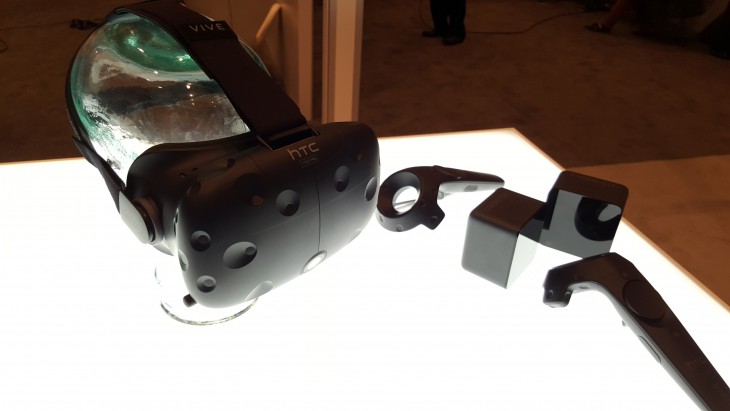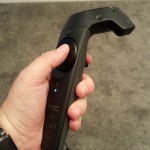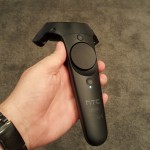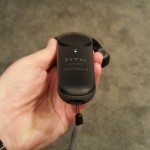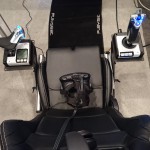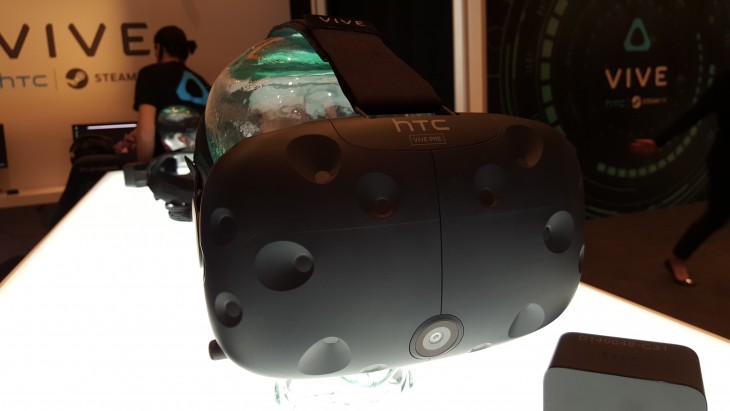
There’s been a lot of interest in HTC’s SteamVR-powered Vive system since its announcement early last year, and some of us in the Ausdroid team have been lucky enough to try out the system at trade shows. I gave it a run at IFA in September and came away impressed. Actually, impressed is a pretty simple word – gobsmacked is probably a better one. Despite the early pre-release cobbled-together nature of the original Vive units, it presented users with a fantastic, immersive experience that left us all wanting more.
Now, HTC’s evolved its kit and is getting ready to bring Vive to market as “Vive Pre”. It’s the first significant change since we first saw the system, and it brings a number of hardware and software changes. HTC’s been running 5 demo stations of their own at CES while the new Vive Pre kits have also shown up elsewhere at the show on partners’ stands.
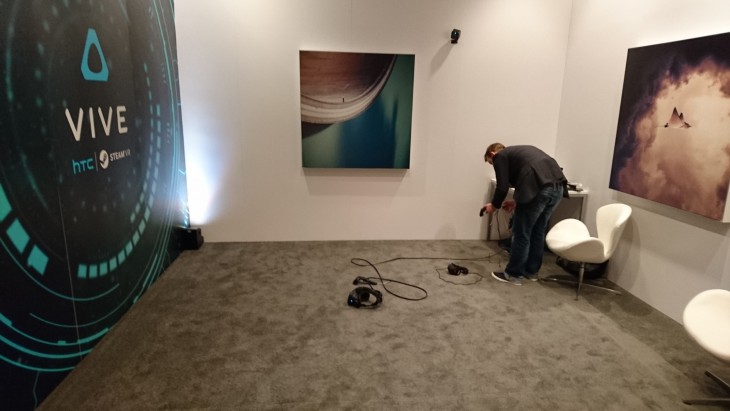
Software-wise, we’re looking at the same demonstrations we’ve seen on Vive over the last year. There’s the gorgeous serene underwater scene as you stand on the deck of a sunken ship with fish, a whales and a stingray swimming past and stopping to look at you; a funny retro-futuristic office simulation where you’re instructed to perform tasks by an overseeing robot – which actually sees you interacting with a virtual computer screen within the demonstration; and of course everyone’s favourite – the Aperture Labs Portal-inspired robot repair workshop.
Having done the demos before, I was maybe a little less impressed by them this time around simply because I knew what was going to happen.
The story this time around is really about the hardware evolutions on the Vive Pre itself, but HTC also had a new type of demo waiting for us at the end … you’ll find a little more about that below.
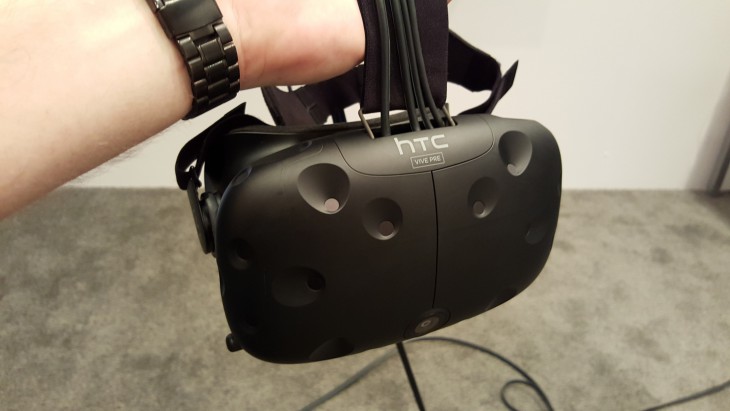
The headset itself is slimmer and lighter than its previous incarnation, and the front of the headset is now rounder. It’s got the look of a giant black golf ball now, where each of the pits is a sensor that works with the two wall-mounted units designed to detect your play area.
HTC’s also adjusted the lenses in the unit so that they better blend the pixels of the screens together – the result of this is a more immersive experience because you’re less aware of the fact that you’re looking at a screen in front of your face. It’s tricking your eyes and your brain in a way that’s much better than before.
The biggest change is the front-facing camera on the unit (which does look like one of the larger cameras from HTC’s Desire Eye phones, but don’t tell them I said that).
The camera adds a few things to the Vive experience. Previously, when you walked near a physical limit of your space, you’d see a Tron-like grid of blue lines appear in your field of view (called the “Chaperone”) to let you know you need to stop moving. Now, Vive will use the camera to detect the shape of objects around you and show a simple outline of what’s happening.
It’s good enough that you can see people walk past you and identify individual objects so you’ll know which way you’re facing and it doesn’t remove you from the Vive experience. If you need more detail there’s a new Camera button on the controller that fills in some of those basic shapes so you can see more of what’s happening.
HTC considers it important that they don’t show you a full high-definition video feed of what the camera is seeing, because you need to be aware on a sensory level that you’re in the Vive unit. It’s an interesting conceit – that users might not be able to tell Vive from the real world – but we’ll let them have it because the effect is so cool. If you REALLY need to see a live feed from the camera, you can hold up the left controller and find a video screen attached to it in this mode.
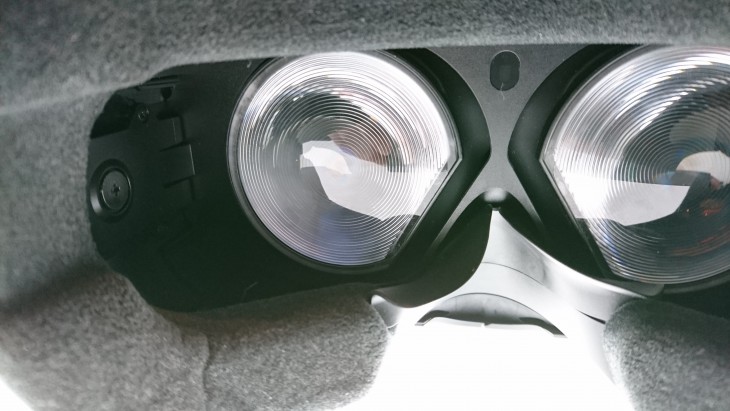
The cables running into the headset are much thinner and lighter on Vive Pre than we’ve seen in previous iterations. Since Vive will be depending on this tether, it’s nice to see it a little less encumbering.
I still maintain this needs to be wireless – I still managed to wrap it around my legs during the demo. Maybe some of the emerging wireless standards will be able to handle the throughput and latency that Vive requires to works its magic. For ideal play I feel like this cabling is best run from your PC to somewhere along the centre of the room.
Controller
The controllers are now much slimmer and lighter, and share the dark grey texture of the Vive Pre headset. The plastic feels much more final, and the HTC logo now stenciled onto the controllers indicates this hardware is probably about ready to go.
The controller is now lighter because it no longer takes individual batteries – it now has a sealed-in battery and recharges over Micro USB. Which the charge time depends on what exactly you hook it up to, maximum play time is said to be about four hours on a single charge.
The top of the controller now features a hollow circle and the same pitted sensors feature on it. The design seems a bit arbitrary (I asked, “why the circle?”) but it turns out that the hollow circle allows placement of the sensors inside it, allowing much better detection of rotation on multiple axes. Colour me impressed.
Elite: Dangerous
HTC also had a little surprise in their demo area – besides the normal Vive demos, they also had a Vive-powered version of Elite: Dangerous to give us a taste of some VR space dogfights.
The setup was pretty simple – each PC had a seat in front of it with flight control sticks (left for accelerate/brake, right for steer/fire) that are visible within the cockpit. Once you’re in the demo, you can turn your head to look around the cockpit of your fighter and follow your enemy as he flies past you (which happens a lot in Elite space combat).
The Elite: Dangerous setup goes to show that Vive can enhance standard PC gaming – there’s no spatial sensitivity required since you’re seated and not moving around, so only the movements of the headset itself are required to build your environment.
Overall, the Vive Pre hardware shows that HTC has a much clearer path to commercial release for their VR system. Some components now look like they’d be ready to ship out tomorrow, and I think there are more than a few people considering clearing out some space in their living rooms to make space for the Vive Pre.
